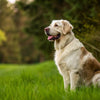How to Get a Malnourished Dog to Gain Weight: A Comprehensive Guide for Loving Pet Owners
- Houndsy
Table of Contents
- Introduction
- Understanding Malnourishment in Dogs
- Veterinary Consultation: The First Step
- Nutritional Strategies for Weight Gain
- Feeding Techniques for Success
- Exercise: The Balancing Act
- Tracking Progress
- Conclusion
- FAQ Section
Introduction
Did you know that nearly 1 in 10 dogs in the U.S. are considered underweight? As pet parents, we are often concerned about our furry friends' weight, and for good reason. A healthy weight is vital for their overall well-being, energy levels, and longevity. If you're reading this, you might be facing the challenge of helping a malnourished dog gain weight, which can be a daunting task.
In this blog post, we aim to provide you with a comprehensive understanding of how to effectively help your dog regain a healthy weight. We'll discuss the signs of malnourishment, dietary considerations, and practical tips on feeding, all while emphasizing the importance of veterinary guidance. By the end of this article, you will have a clearer path to nourishing your beloved companion back to health.
Together, we will explore the various facets of this topic, including identifying malnourishment, the types of foods that promote weight gain, and how to create a supportive environment for your dog. We'll also delve into the significance of proper feeding techniques and supplements that can aid in your dog's recovery. As responsible pet owners, it’s essential to be mindful of the choices we make for our pets, and we hope this guide will empower you to take action.
Understanding Malnourishment in Dogs
What is Malnourishment?
Malnourishment in dogs occurs when there is a deficiency of essential nutrients in their diet, leading to weight loss and various health issues. This can stem from either inadequate food intake or an inability to absorb nutrients effectively due to underlying medical conditions.
Signs of Malnourishment
Recognizing the signs of malnourishment is the first step in addressing your dog's weight issue. Some common indicators include:
- Visible Ribs and Spine: If your dog's ribs or spine are prominent, this is a clear sign of low body fat.
- Dull Coat: A lackluster coat may indicate nutritional deficiency.
- Lethargy: If your dog seems tired or uninterested in activities they once enjoyed, this could signal malnourishment.
- Gastrointestinal Issues: Diarrhea, vomiting, or gas can be signs of digestive problems related to malnutrition.
- Weakness: A noticeable decrease in energy levels or physical strength.
Causes of Malnourishment
Understanding the root cause of your dog's malnourishment is crucial. Possible reasons may include:
- Poor Quality Diet: Not all dog food is created equal. Low-quality food may lack essential nutrients.
- Health Conditions: Conditions like gastrointestinal disorders, parasites, or metabolic diseases can hinder nutrient absorption.
- Stress: Changes in environment or routine can affect a dog's appetite and eating habits.
- Neglect: Sadly, many malnourished dogs come from situations of neglect or abandonment.
Veterinary Consultation: The First Step
Before embarking on any weight gain journey, it’s essential to consult with your veterinarian. They can provide a thorough examination to rule out underlying health issues and may recommend diagnostic testing to assess your dog’s overall health.
Body Condition Score (BCS)
Your veterinarian will likely use a Body Condition Score (BCS) to evaluate your dog’s weight. This score ranges from 1 to 9, with scores of 4 or 5 indicating a healthy weight. Dogs scoring below 4 are considered underweight, and your vet can help determine a target weight for your dog based on their breed and age.
Nutritional Strategies for Weight Gain
Once you have a clear understanding of your dog’s health status, it’s time to focus on nutrition. Here are some key factors to consider:
1. High-Calorie Diets
Opt for high-calorie dog foods designed for weight gain. These typically contain elevated levels of protein and fat, which are essential for muscle development and overall energy. Look for foods that meet the following criteria:
- Protein: Aim for at least 25-30% protein content.
- Fat: Choose foods with a minimum of 18% fat content, as fat provides more calories per gram than protein or carbohydrates.
- Digestibility: Foods that are easy to digest will ensure your dog can absorb the nutrients effectively.
2. Puppy Food
If your dog is underweight, consider feeding them puppy food, which is often higher in calories, protein, and fat than adult formulas. Puppy food is particularly beneficial for younger dogs, but it can also help adult dogs gain weight.
3. Homemade Diets
If you're inclined to prepare homemade meals for your dog, consult with a veterinary nutritionist to ensure that their diet is balanced and meets all nutritional requirements. Incorporating ingredients like chicken, rice, sweet potatoes, and healthy fats can enhance palatability and calorie density.
4. Supplements
Adding nutritional supplements can greatly benefit your dog during their weight gain journey. Some beneficial options include:
- Probiotics: These support gut health and improve nutrient absorption.
- Omega-3 and Omega-6 Fatty Acids: These can help improve skin and coat health and support overall wellness.
- Vitamins and Minerals: A broad-spectrum vitamin supplement can help fill any nutritional gaps in your dog's diet.
Feeding Techniques for Success
1. Increase Meal Frequency
Instead of feeding one or two large meals a day, we recommend splitting your dog's daily food intake into smaller, more frequent meals. Aim for 4-5 small meals throughout the day to keep their metabolism active and encourage consistent eating.
2. Monitor Portion Sizes
While it’s essential to increase calorie intake, be cautious not to overfeed, as this can lead to digestive upset. Gradually increase portion sizes and monitor your dog’s reaction.
3. Create a Calm Eating Environment
Ensure that your dog’s feeding area is quiet and free from distractions. Stress can hinder their appetite, so a peaceful setting can encourage them to eat more comfortably.
4. Keep Fresh Water Accessible
Always provide fresh water to keep your dog hydrated. Proper hydration is vital for overall health and aids in digestion.
Exercise: The Balancing Act
While it may seem counterintuitive, regular exercise is essential for dogs, even those who are underweight. Gentle activities like short walks and light play can stimulate appetite and maintain muscle tone without burning excessive calories.
Gentle Activity Recommendations
- Take your dog for short walks, gradually increasing the distance as they gain strength and weight.
- Engage in low-impact play sessions that encourage movement without overexertion.
Tracking Progress
Monitoring your dog’s weight and overall health during this journey is crucial. We recommend:
- Regular Weigh-Ins: Weigh your dog weekly to track progress. If they’re not gaining weight after a few weeks, consult your vet for further guidance.
- Health Monitoring: Keep an eye on your dog’s energy levels, coat quality, and overall demeanor. Any changes should be reported to your veterinarian.
Conclusion
Helping a malnourished dog gain weight requires a thoughtful and compassionate approach. By understanding the underlying causes of their weight issues, consulting with your veterinarian, and implementing a well-rounded nutritional and exercise plan, we can guide our furry companions back to health.
It's important to remember that the journey may take time, and patience is key. Throughout this process, you’ll not only be helping your dog gain weight but also strengthening the bond you share.
If you're looking for a convenient and innovative way to manage your dog’s feeding routine, consider exploring the Houndsy Kibble Dispenser. Our product is designed to simplify the feeding experience, ensuring that your pet receives the right portions every time while fitting seamlessly into your home décor.
FAQ Section
What should I do if my dog refuses to eat?
If your dog is refusing food, it may be due to stress or an underlying health issue. Consult with your veterinarian to address any potential medical concerns and get advice on how to encourage eating.
Can I use human food to help my dog gain weight?
Yes, you can incorporate safe human foods like cooked chicken, rice, sweet potatoes, and certain vegetables into your dog's diet. Just be cautious to avoid harmful ingredients like onions and chocolate.
How long will it take for my dog to gain weight?
The time it takes for a dog to gain weight varies based on their individual circumstances, including age, health, and the plan you implement. It’s best to aim for gradual weight gain to avoid health complications.
Is it safe to feed my dog multiple times a day?
Yes, feeding your dog multiple small meals throughout the day is generally safe and can help with weight gain by stimulating appetite and ensuring they consume enough calories.
What if my dog still doesn’t gain weight after a dietary change?
If you see no improvement in your dog’s weight after a few weeks of adjusting their diet and feeding routine, it’s important to return to your veterinarian for further evaluation and potential dietary adjustments.
By following the guidelines outlined in this post, we can collectively ensure that our furry friends thrive, feeling and looking their best. Let's work together to provide them with the love and care they deserve!












